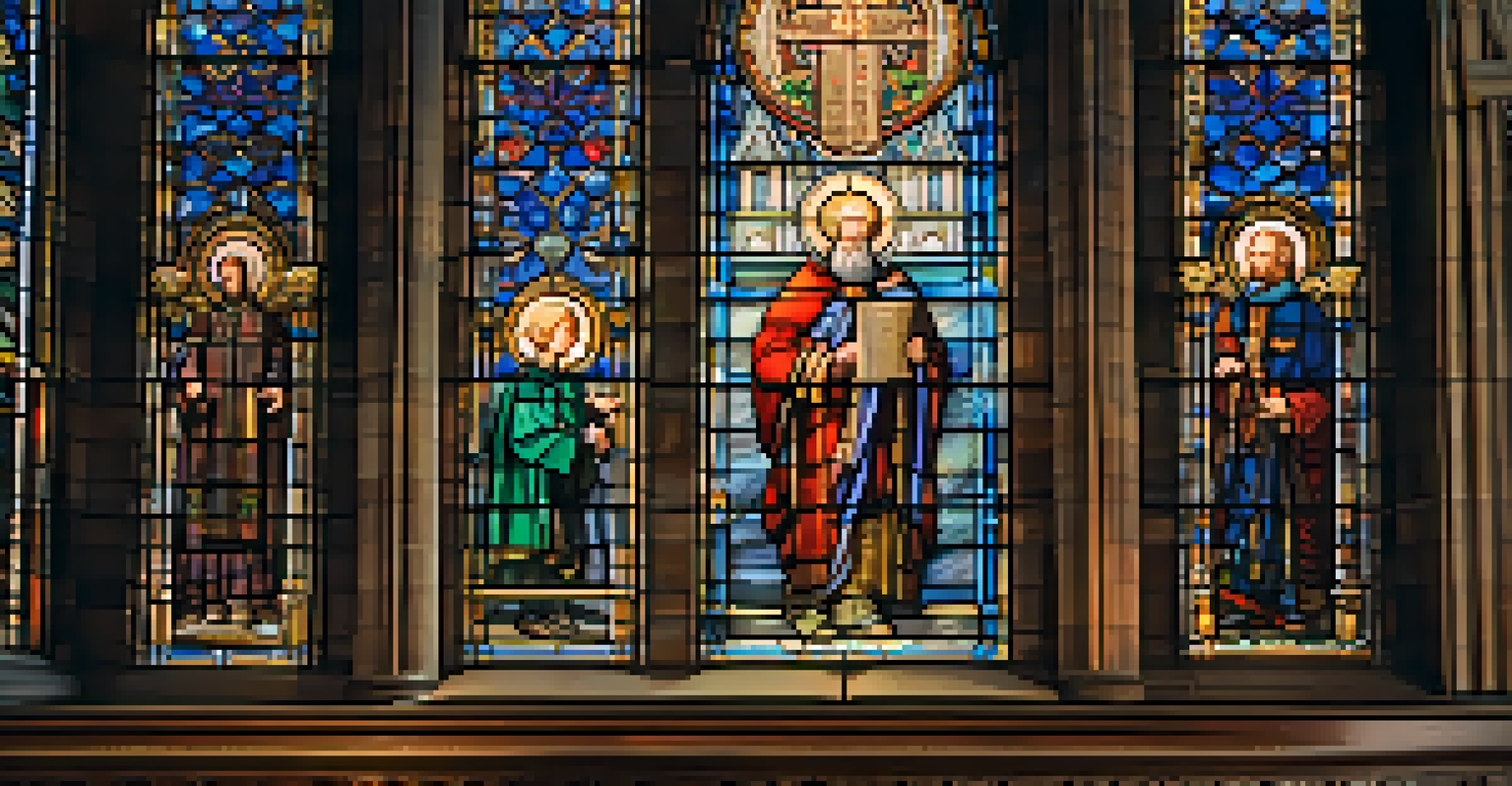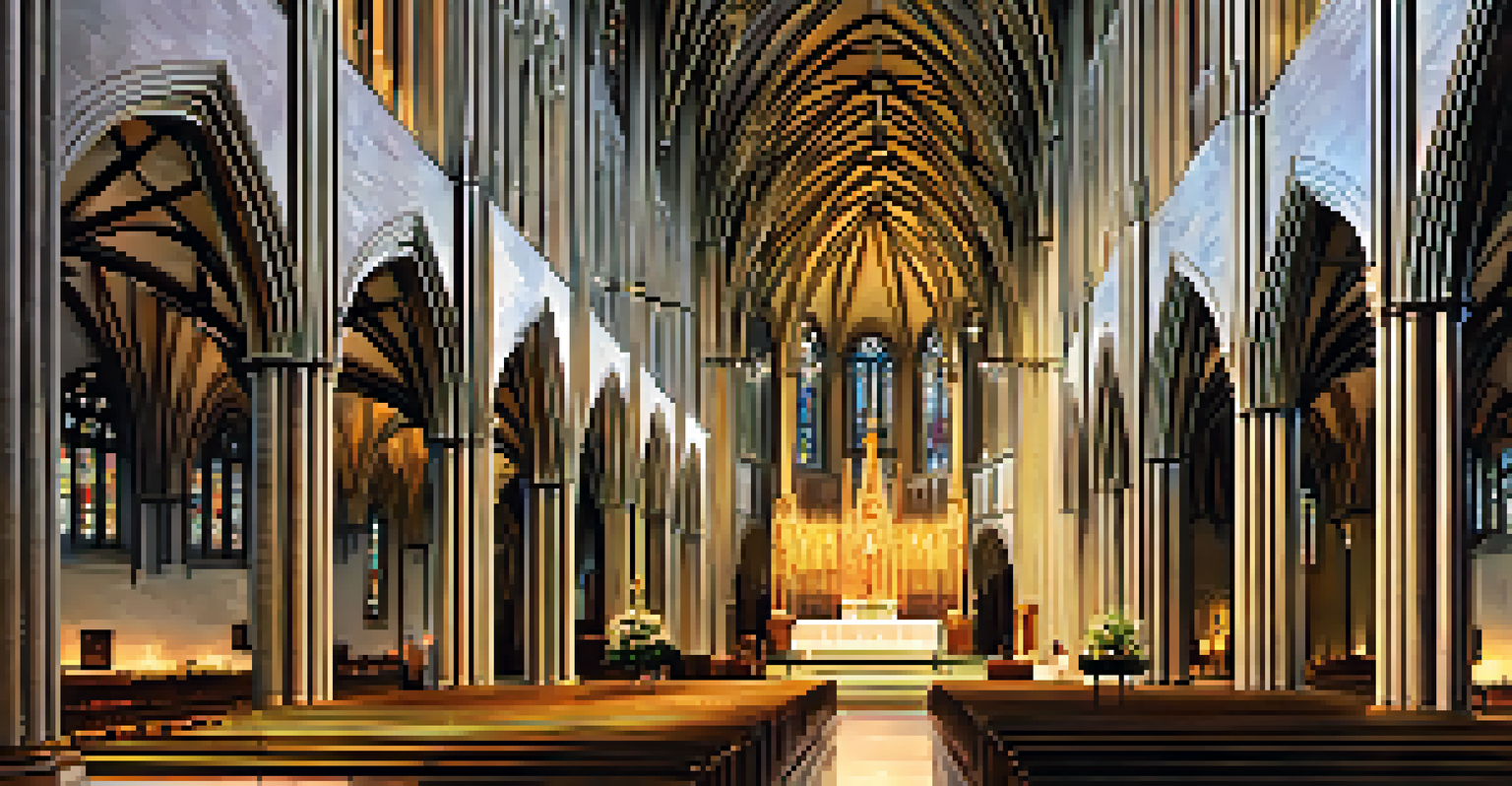Exploring the Gothic Revival: St. Patrick's Cathedral in NYC

Introduction to St. Patrick's Cathedral and Its Importance
St. Patrick's Cathedral, an iconic landmark in New York City, stands as a testament to the Gothic Revival architecture that flourished in the 19th century. Completed in 1878, this majestic structure serves as a center of worship and community for countless New Yorkers. Its location on Fifth Avenue makes it a striking contrast to the modern skyscrapers that surround it, symbolizing the city's rich history and cultural diversity.
Architecture is the learned game, correct and magnificent, of forms assembled in the light.
The cathedral is not just an architectural marvel; it is also a spiritual haven for many. With its impressive spires and intricate stained glass windows, it draws visitors from around the globe, eager to witness its beauty. This blend of artistry and faith makes St. Patrick's a significant site, both for the Catholic Church and for the city itself.
As we explore the Gothic Revival style embodied by St. Patrick's, we will uncover what makes this cathedral a masterpiece of design and a vital part of New York's identity. From its historical significance to its architectural details, the cathedral offers a unique glimpse into the past.
The Historical Context of the Gothic Revival Movement
The Gothic Revival movement began in the late 18th century, drawing inspiration from medieval Gothic architecture. This style emphasized verticality, intricate details, and a sense of grandeur that was often associated with cathedrals and churches. The movement aimed to revive the ideals of craftsmanship and spirituality that characterized earlier periods.

In the United States, the Gothic Revival gained momentum in the mid-19th century, coinciding with a growing interest in European architectural styles. Architects sought to create structures that conveyed both beauty and a sense of connection to the divine. St. Patrick's Cathedral, designed by architect James Renwick Jr., stands as a prime example of this period's architectural innovation.
Architectural Marvel of NYC
St. Patrick's Cathedral showcases stunning Gothic Revival architecture, blending historical significance with breathtaking design.
The choice of Gothic Revival for St. Patrick’s Cathedral was not merely aesthetic; it also symbolized the aspirations of the Catholic community in America. The cathedral represented a return to tradition amid the rapid changes of the industrial age, reflecting the desire for spiritual grounding in a bustling urban environment.
Architectural Features of St. Patrick's Cathedral
St. Patrick's Cathedral boasts a range of architectural features that exemplify the Gothic Revival style. Its soaring spires reach a height of 330 feet, making it one of the tallest cathedrals in the United States. The intricate facade, adorned with statues and detailed carvings, invites visitors to marvel at the craftsmanship that went into its construction.
A building has two lives. The one it lives and the one it does not live. The one that is understood is not the one that counts.
Inside, the cathedral is equally breathtaking, with vaulted ceilings that create an airy atmosphere. The stunning stained glass windows, many of which date back to the 19th century, depict biblical scenes and saints, casting colorful light across the interior. This interplay of light and architecture enhances the spiritual experience for worshippers and visitors alike.
Additionally, the use of flying buttresses supports the weight of the walls while adding to the aesthetic appeal of the structure. These features not only serve a functional purpose but also contribute to the overall grandeur that makes St. Patrick's Cathedral a must-see landmark in New York City.
The Role of St. Patrick's Cathedral in NYC Culture
Beyond its architectural beauty, St. Patrick's Cathedral plays a significant role in the cultural fabric of New York City. As a hub for religious ceremonies, it hosts everything from daily masses to grand events like weddings and ordinations. This makes it a vital space for the local Catholic community and beyond.
Moreover, the cathedral is a popular site for tourists and locals alike, offering a peaceful retreat from the city's hustle and bustle. Visitors often come to admire its beauty, reflect in its serene environment, or attend special events. This blend of spirituality and tourism enriches the cathedral's cultural significance.
Cultural Hub for the Community
The cathedral serves as a vital space for religious ceremonies and community engagement, enriching the cultural fabric of New York City.
St. Patrick's also engages with contemporary issues, hosting events that address social justice and community concerns. This active involvement demonstrates that the cathedral is not just a relic of the past but a living institution that continues to resonate with the people of New York City.
Preservation Efforts for St. Patrick's Cathedral
Preserving the beauty and integrity of St. Patrick's Cathedral is an ongoing commitment for the Archdiocese of New York. Over the years, various restoration projects have aimed to maintain the cathedral's structural integrity and aesthetic appeal. These efforts ensure that future generations can appreciate this architectural gem.
The most significant restoration project took place from 2012 to 2015, during which extensive work was done on the roof, facade, and interior. This project not only addressed necessary repairs but also enhanced the overall visitor experience. Careful attention was paid to retaining the original craftsmanship while incorporating modern techniques.
Community support plays a crucial role in these preservation efforts. Fundraising initiatives and donations from parishioners and visitors help fund the ongoing maintenance and restoration projects, ensuring that St. Patrick's Cathedral remains a vibrant part of New York City's landscape for years to come.
Visiting St. Patrick's Cathedral: What to Expect
Visiting St. Patrick's Cathedral is an experience that combines history, art, and spirituality. Open to the public, the cathedral welcomes visitors from all backgrounds to explore its stunning architecture and serene atmosphere. Whether you're attending a service or simply touring the space, there's something for everyone to enjoy.
As you enter, take a moment to appreciate the grand entrance and the beautiful details that adorn the interior. Visitors often find themselves captivated by the majestic altars and the light filtering through the stained glass windows. Guided tours are available, providing insights into the cathedral's history and architectural significance.
Architectural Mastery of the Cathedral
St. Patrick's Cathedral is a stunning example of Gothic Revival architecture, featuring soaring spires, intricate designs, and breathtaking stained glass windows.
It's also worth noting that St. Patrick's Cathedral hosts various events throughout the year, including concerts and holiday celebrations. These events allow visitors to experience the cathedral in a different light, making it a dynamic place that evolves with the seasons and the community's needs.
Conclusion: The Enduring Legacy of St. Patrick's Cathedral
In conclusion, St. Patrick's Cathedral stands as a remarkable example of Gothic Revival architecture, embodying the spiritual and cultural spirit of New York City. Its intricate design and historical significance have made it a cherished landmark for both residents and visitors. The cathedral not only serves as a place of worship but also as a symbol of resilience and beauty amidst the city's ever-changing landscape.
As we explored its architectural features, historical context, and cultural role, it’s clear that St. Patrick's Cathedral is more than just a building; it’s a living testament to the values of faith and community. The ongoing preservation efforts ensure that this iconic structure will continue to inspire awe for generations to come.

Whether you're drawn to its artistry, history, or spiritual significance, St. Patrick's Cathedral invites you to experience its magic. It stands as a reminder of the power of architecture to unite us and the enduring legacy of faith in the heart of New York City.